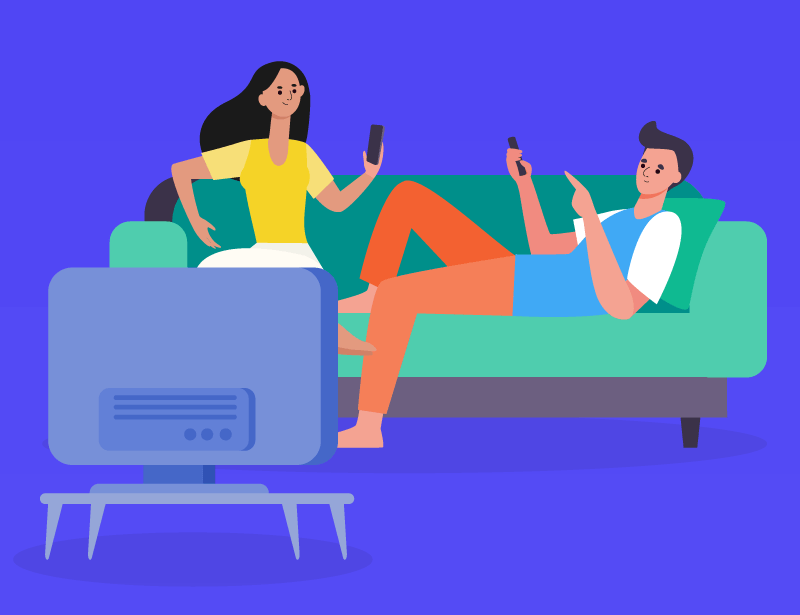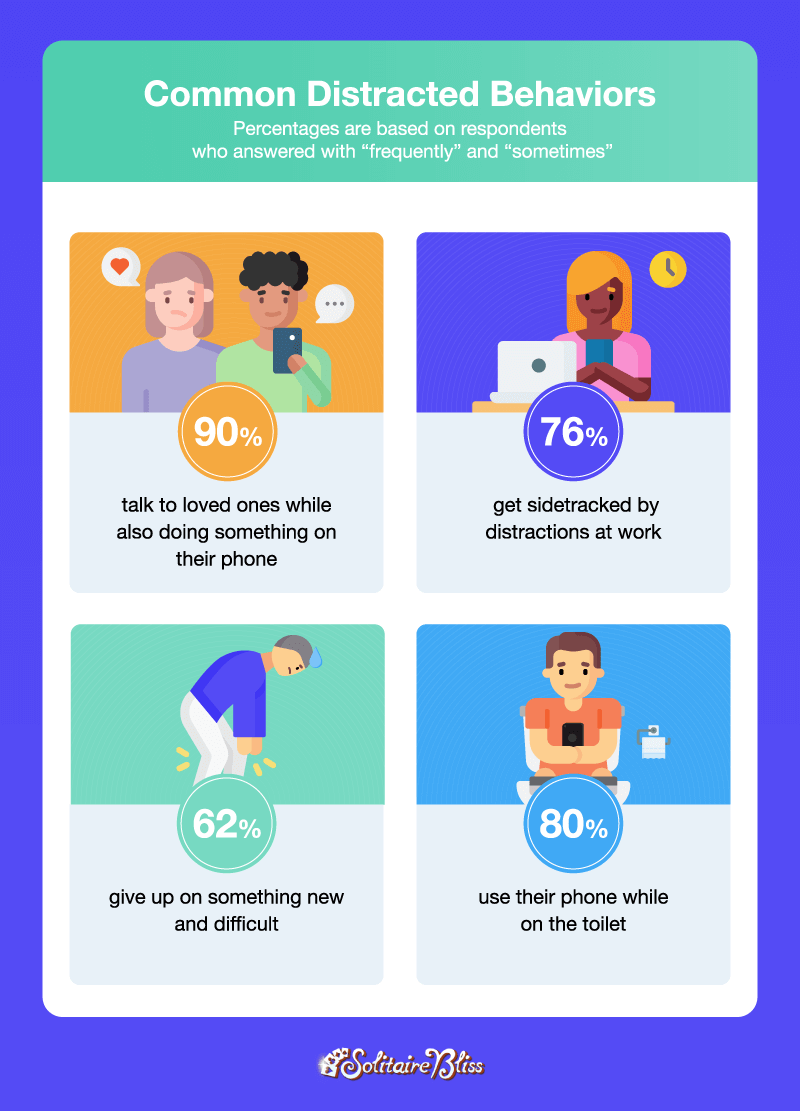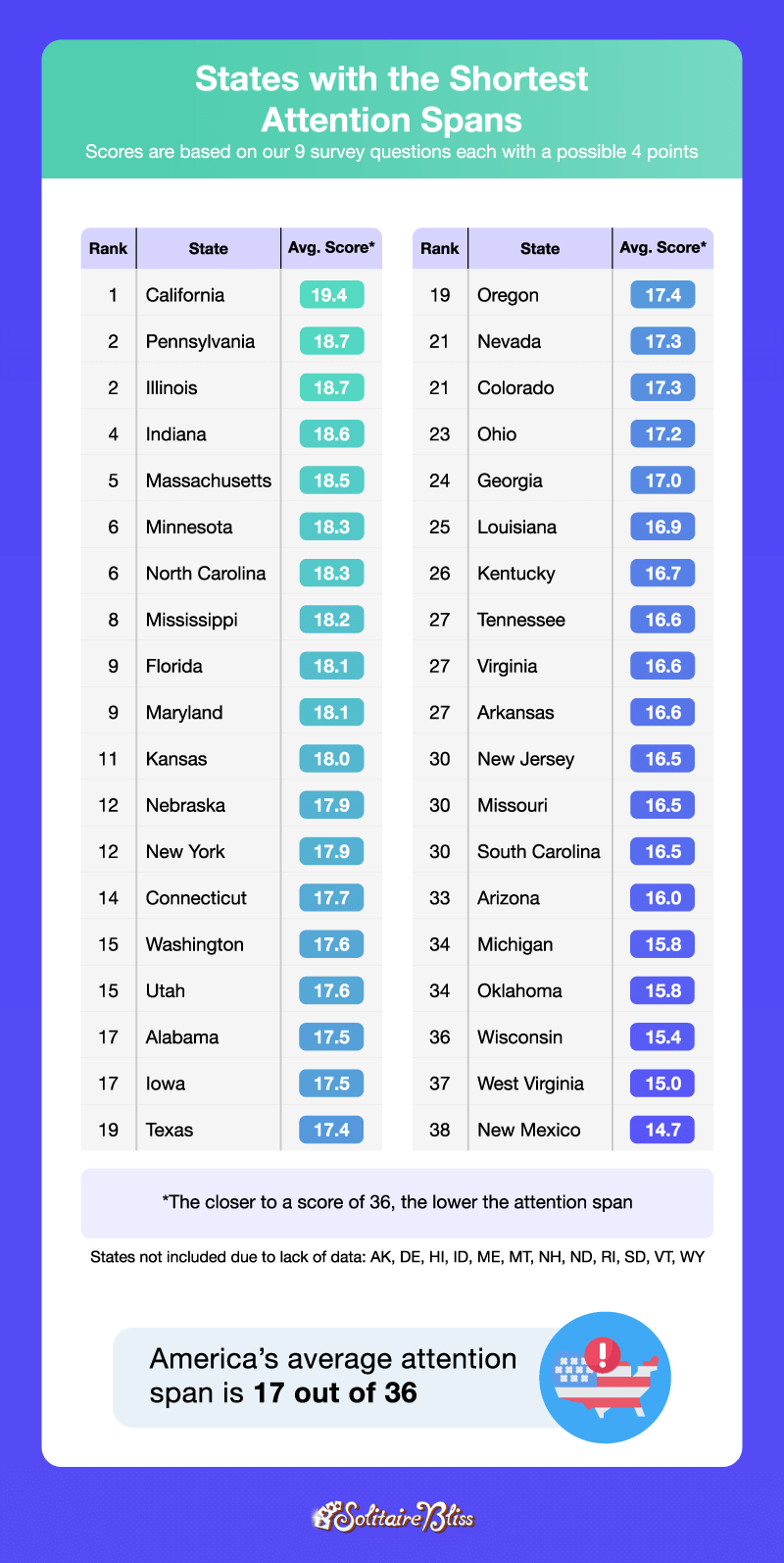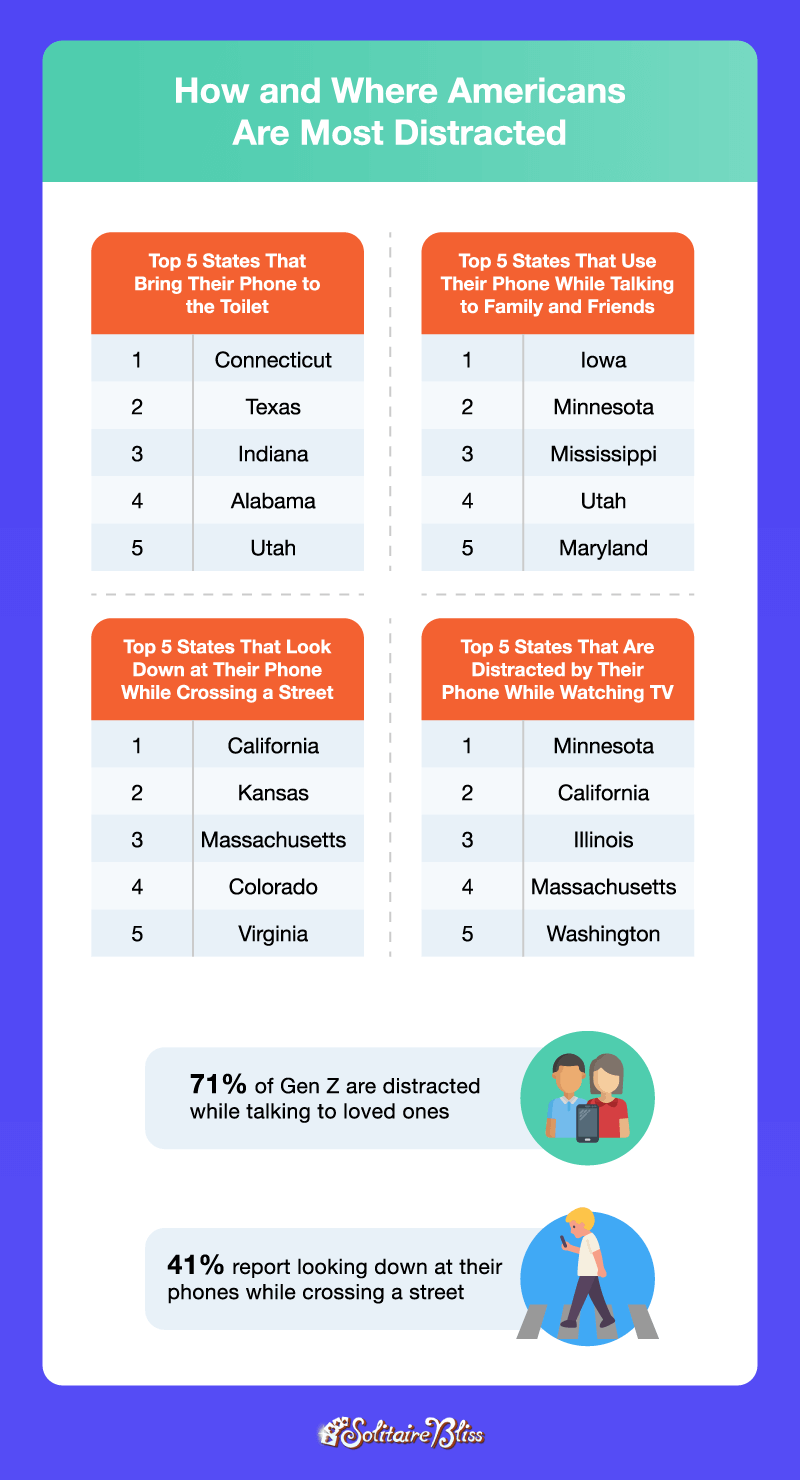Study Shows Which U.S. States Have the Shortest Attention Spans

Studies have shown that looking at your phone provides you with a hit of dopamine, the “feel-good” hormone. Each time your phone dings with a new notification, dopamine levels in your brain spike, giving you a sense of pleasure and taking your attention away from reading, talking to your friends, or whatever the task may be.
According to a Harvard University study, our brains contain a “pleasure pathway” responsible for different cognitive-behavioral functions including our attention spans. So, it’s no wonder we found that 80% of Americans take their phones to the toilet with them at least sometimes—scrolling through Instagram is a much more rewarding and pleasurable pathway for our brains than staring at the wall!
As smartphones and games like solitaire become more commonplace among generations, we set out to discover how Americans’ attention spans are enduring during this Age of Distraction. We surveyed over 2,000 Americans on their experiences with their current attention spans and everyday habits, such as using the toilet and talking to friends on the phone. Then we analyzed our findings by state, age, and gender to give you an eye-catching ranking of states with the shortest attention spans.
Key Findings
-
The states with the shortest attention spans are California, Pennsylvania, and Illinois.
-
A majority of Americans (80%) bring their phone to the toilet at least sometimes.
-
Women use their phones while watching TV more than men.
-
Gen Z has the shortest attention span compared to millennials, Gen X, and baby boomers.

How We Measured Attention Span
We asked residents of each U.S. state a series of nine questions and used their answers to establish an average attention score for that state. With the 9 questions each worth up to 4 points, we found that America’s average attention span is 17 out of 36.

California Has the Shortest Attention Span Overall
With a score of 19.4 out of 36, Californians answered most of our questions with “frequently,” making them the state with the shortest attention span. The Golden State is followed up by Pennsylvania (18.7) and Illinois (18.7). Accordingly, the states with the highest attention spans are New Mexico (14.7), West Virginia (15.0), and Wisconsin (15.4). Maybe these are the golden states, after all!

In addition to a state-by-state comparison, we were also curious about people’s perceptions of their own attention spans. We found that residents of Connecticut believe that they have a higher than average attention span (ranked themselves #33 on our survey), when in reality, their average score (17.7) is more closely aligned with the national average at #14.
Are Our Attention Spans Going down the Drain?
Sitting on the toilet is a boring task for the 80% of Americans who bring their phone to the bathroom with them at least sometimes. Within that 80% lies a majority of people from Connecticut—that state brings their phone to the toilet the most (81%).
When analyzing these findings with gender, we found that men (81%) crave a dopamine rush while on the toilet more often than women (79%). While men in Texas (88%) are especially guilty of this short-attention behavior, women aren’t completely innocent: Indiana (78%) has the highest number of women who take their phones to the toilet.
Our curiosity didn’t end with gender. Often regarded as the generation “raised on smartphones,” so, it’s no surprise that Gen Z (92%) brings their phones to the toilet more than any other generation.
Large Majority Use Their Phones While Talking to Family or Friends
With 90% of Americans being at least sometimes distracted by phones when talking to family or friends, it’s no surprise that people feel more disconnected to each other than ever. We found that the state with the shortest attention when it comes to talking to family, friends, or a partner is North Carolina (80%).
Unlike the toilet scenario, men are not the guiltiest here as 94% of women reach for their phones while talking to loved ones compared to 87% of men. It appears to us that Americans are connected electronically via likes and comments and hashtags, but are disconnected from each other in reality.
But can Gen Z’s grannies and grampies or even their friends compete with TikTok? Our findings say no, as Gen Z makes up the majority (94%) of Americans who are distracted by their phones while conversing with family or friends at least sometimes. Next time your friend is telling that story at the dinner table again, try to resist the dopamine craving and give them your full attention.
Men Are Guiltiest of Looking Down at Their Phones While Crossing the Street
Some Americans could use a lesson on street safety as 41% look down at their phones as they cross a street. The most distracted pedestrians are out West, as 40% of Californians admit to this short-attention behavior.
Men are once again the culprit as 43% look down at their phones at least sometimes while crossing a street compared to 39% of women. We get it—taking the same morning commute to work every day can become boring. While playing on our phones can help make that daily trek more interesting everyone needs to stay safe on the streets by simply paying attention.
Who should be in charge of all street safety lessons? We think it’s Baby Boomers. Boomers, of which only 13% report being distracted, are ultra-safe when crossing the street compared to our youngster Gen Zs (57%).
Phones Prove Distracting Even While Watching TV
“Netflix and Chill” turns into “Netflix and Scroll” as 92% of Americans report using their phones while watching TV. Women outnumber men at 94% reaching for their phones at least sometimes while watching TV compared to 89% of men.
Upon further research, we found that many people enjoy tuning into older shows for feelings of familiarity and comfort. So, if you already know Phoebe Buffay’s lines word for word, there’s not much dopamine to be had from “watching” TV, so it makes sense that Americans reach for their phones while the TV is on.
In regard to generation, at 94%, Gen Z “Netflix and Scrolls” more than any other age group, but millennials are very close behind at 93%. At least they’re not hurting the TV’s feelings by not paying close attention to it.

Conclusion
It’s clear that many Americans crave the dopamine that comes from using phones and are therefore frequently distracted when performing everyday tasks. This behavior can come across as having a short attention span and can even be perceived negatively by others. Nevertheless, next time you need to give into boredom, reach for a Solitaire app instead of mindlessly scrolling — just make sure to pay attention when crossing the street.
Methodology
Survey among 2,055 Americans. Data was collected from January 16–20, 2023. Respondents ranged in age from 18 to 76 years old, and were 52% female, 46% male, and 2% nonbinary. We scored each survey question a 0, 2, or 4; 0 (answers of “never”) being a high attention span because they don’t get distracted frequently and 4 being a low attention span because they report distracted behaviors “frequently.” States not included due to lack of data: AK, DE, HI, ID, ME, MT, NH, ND, RI, SD, VT, WY.
Back to the Homepage

